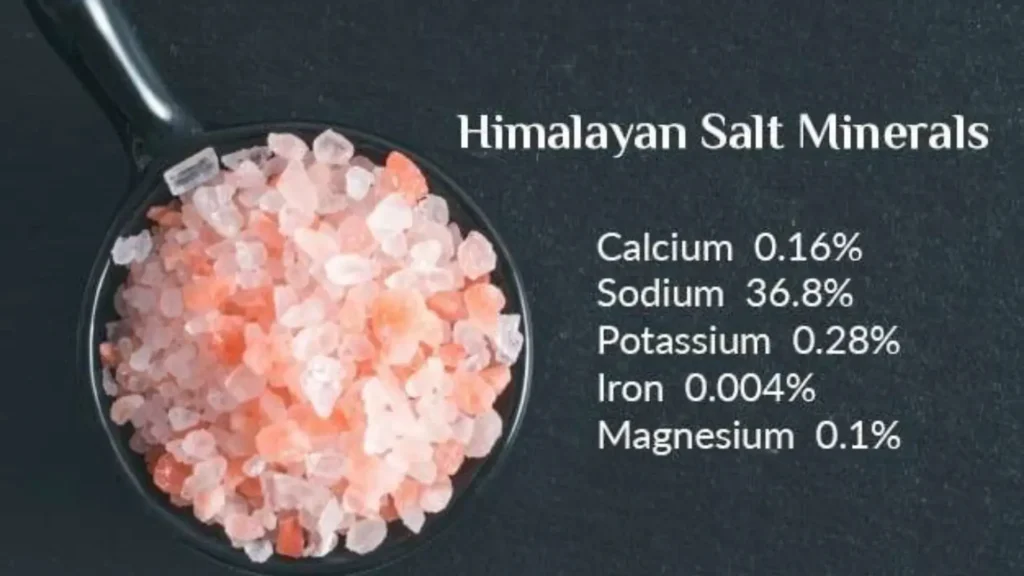What is Pink Himalayan Salt?
Himalayan pink salt is a type of rock salt mined in Pakistan, in the
Salt Range south of the Himalayas.[8] The pink tint may come
from trace minerals that are not nutritionally significant.

Himalayan pink salt is prized not just for its color and purity, but also for its rich mineral composition. Known to contain up to 84 trace minerals, this natural salt has become popular in kitchens, wellness routines, and health circles worldwide. From calcium and magnesium to iron and potassium, the unique blend of minerals in Himalayan pink salt gives it more than just flavor, it offers a natural source of nutrients that support overall well-being. In this blog, we’ll explore the full mineral profile of pink Himalayan salt, its benefits, and why so many people prefer it over refined table salt.

Himalayan pink salt is made up of about 95–98% sodium chloride, which is the same basic ingredient in regular salt. The rest is made up of other minerals, which give it both its pink color and extra value. These minerals are what set it apart from other types of salt.

Himalayan pink salt contains a wide range of trace minerals that give it its unique color, flavor, and health-supporting properties. Here are some of the most important minerals found in this natural salt:
Magnesium supports muscle function, helps manage stress, and plays a vital role in over 300 biochemical reactions in the body. It’s one of the key minerals that makes Himalayan salt a wellness favorite.
Potassium helps balance fluid levels in the body, supports healthy blood pressure, and is essential for proper nerve and muscle function.
Iron gives pink salt its distinct rosy hue. It also supports oxygen transport in the blood and helps fight fatigue and weakness.
Known for strengthening bones and teeth, calcium is also important for muscle movement and nerve signaling. Himalayan salt contains small amounts that contribute to your daily intake.
While Himalayan salt contains only trace amounts of natural iodine, it can still support thyroid function to some extent. However, it shouldn’t replace iodized salt if iodine intake is a concern.
Manganese supports bone development, metabolism, and the formation of antioxidants. Even in small amounts, it plays an important role in body function.
Read More: Antibacterial Properties Of Himalayan Salt
Though needed in only tiny amounts, vanadium may support insulin activity and help with carbohydrate metabolism.
Chromium plays a role in blood sugar control and how the body uses carbohydrates and fats. It’s another trace mineral that adds value to Himalayan pink salt.
Even though the trace minerals in Himalayan salt are very limited in quantity, they are part of what makes this salt feel more natural and less processed. These minerals are not normally found in regular table salt, which is often cleaned and treated with chemicals.
While Himalayan salt shouldn’t be treated like a vitamin supplement, many people still prefer it for its more natural mineral profile.
Here’s a quick look at the average nutritional values found in 1 gram of Himalayan pink salt:
These values may vary slightly based on where the salt is mined, but they give a general idea of what you get in each pinch of salt. You might also like to read Types Of Grains In Himalayan Salt.
One of the biggest reasons people choose Himalayan salt is because of its purity. It is mined from salt deposits that are over 250 million years old and protected underground. This means it hasn’t been exposed to modern pollution or harmful chemicals.
Trusted suppliers like Sobaan Salts make sure the salt is naturally cleaned and free of harmful substances. It’s usually hand-mined and minimally processed to keep its original qualities intact.
Final Words
Himalayan pink salt is valued not just for its Pink color but for its natural mineral content. Known to contain up to 84 trace minerals, this salt offers a more authentic and less processed option compared to regular table salt. While it’s not a substitute for medical treatment or supplements, many people choose it as a healthier alternative for daily use.
Knowing what the 84 minerals in Himalayan pink salt are helps you choose better for your health. For those seeking purity and trusted quality, Sobaan Salts offers Himalayan pink salt that delivers the natural benefits of all 84 minerals in Himalayan pink salt.
Himalayan pink salt, mined primarily from Pakistan’s Khewra Salt Mine, is often praised for its mineral content. A 2020 study found it contains approximately 2695 mg/kg calcium, 2655 mg/kg magnesium, and 2406 mg/kg potassium, significantly more than table salt. These minerals give the salt its distinctive color but are present in small amounts, offering limited nutritional benefits in typical servings. (Source: PubMed Central)
References:
1. Khan et al., 2017, Pakistan Journal of Scientific & Industrial Research. “Chemical Characterisation of Himalayan Rock Salt.”
https://v3.pjsir.org/index.php/physical-sciences/article/download/10/9/
2. USGS (U.S. Geological Survey). “Salt, Sodium, Chlorine.”
https://www.usgs.gov/media/images/salt-sodium-chlorine
3. Di Salvo E. et al., 2023, Toxics (MDPI). “Gourmet Table Salts: The Mineral Composition Showdown.”
https://www.mdpi.com/2305-6304/11/8/705
Himalayan pink salt is a type of rock salt mined in Pakistan, in the
Salt Range south of the Himalayas.[8] The pink tint may come
from trace minerals that are not nutritionally significant.

WhatsApp us